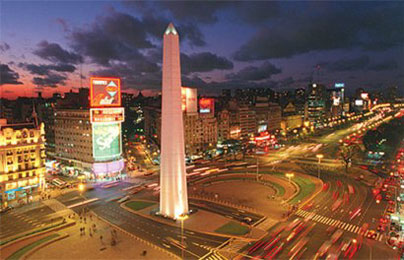
Buenos Aires has always been an open-door city. Its inhabitants are called Porteños, which makes reference to the fact that the city is a port.
Porteños are warm and hospitable: they usually invite tourists for lunch or dinner at their homes and prepare typical food.
Porteños are warm and hospitable: they usually invite tourists for lunch or dinner at their homes and prepare typical food.
The characteristic infusion is the mate. It is prepared by pouring warm water into a gourd, also called “mate” that contains “yerba mate”.
Some people add sugar into the infusion, but most of the “Porteños” prefer "amargo" (a mate without sugar).
Language & Slang language
Spanish is the official language. Most of the people working in areas related to tourism speak English fluently.
The argentine Spanish slang is spoken in Buenos Aires by the "porteños" (the inhabitants of Buenos Aires). Slang is usually not spoken when a formal conversation is taking place. It’s also used in tango lyrics, called “lunfardo” slang created as deformation of the origin language by immigrants.
ARGENTINA TOURIST INFORMATION:
Secretaría de Turismo de la Nación ( National Tourism Office ) Santa Fe Av. 883, Bs As. Tel: (5411) 4312-5550 or 4312-2232 info@turismo.gov.ar
BUENOS AIRES CLIMATE & WEATHER
Buenos Aires has a temperate climate with average temperatures ranging from 35°C (94°F) in January to 10°C (50°F) in July. The heaviest rain falls during the winter months, though rain can be expected at any time of year.
The climate of Buenos Aires is mild all year round. The mean annual temperature is 18º C (64.4º F), making extremely hot and cold days very infrequent. Thus, visitors can enjoy walking around the city in any season.
July is the coldest month. Although frosts are rare, a woollen coat, a jacket or an overcoat and a scarf will be required when going out. In winter, cold is moderate during the day, but temperature considerably drops at night.
In summer, the weather is hot and humid. Mornings are warm and during midday and the first hours of the afternoon, the temperature rises. At night, temperature goes down slightly, so people may wear light clothes; coats are not needed.
Rains are more frequent in autumn and spring (from March to June and from September to December, respectively). They are mild or last a short time, thus activities are not hampered and people usually go out with an umbrella or a raincoat.
In the sunny days of autumn and spring, mornings are slightly cold; the temperature rises at midday and drops again at night.
Remember: DAR Discount Argentina has a lot of gifts waiting for you: Many stores-museums-restaurants-ski resorts-vacation and wine resorts-bars-Tango shows, etc. in Argentina will offer you the best discounts and a very special gift just showing your DAR Discount Argentina CARD.
For more information follow the link:
http://www.discountargentina.com/












No comments:
Post a Comment